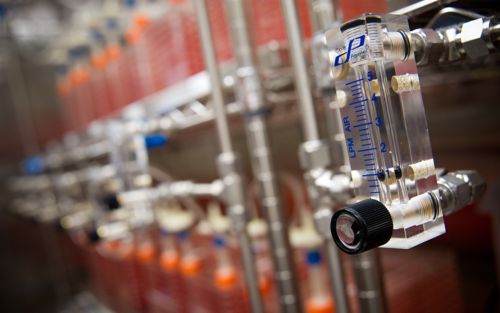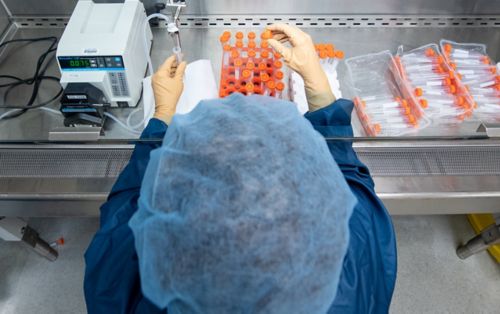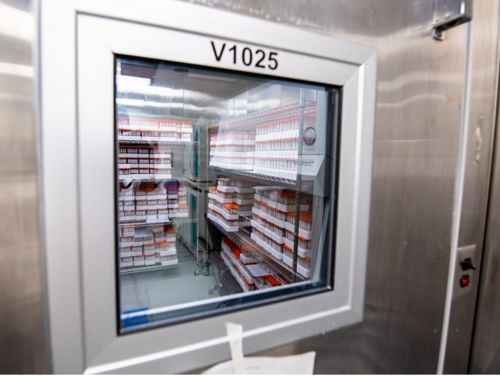St. Jude Family of Websites
Explore our cutting edge research, world-class patient care, career opportunities and more.
St. Jude Children's Research Hospital Home

- Fundraising
St. Jude Family of Websites
Explore our cutting edge research, world-class patient care, career opportunities and more.
St. Jude Children's Research Hospital Home

- Fundraising
Good Manufacturing Practices (GMP) Facility
Launched in 2003, the GMP facility plays a critical role in moving promising discoveries from St. Jude laboratories into our clinics, ensuring that biopharmaceuticals and other biological products for patient use are manufactured in accordance with strict federal regulations.
OVERVIEW
St. Jude opened the doors of children’s GMP manufacturing facility in 2003. The children’s GMP facility is accredited by the Foundation of the Accreditation of Cellular Therapy (FACT).
The St. Jude GMP facility has unparalleled product depth and breadth and provides St. Jude with the ability to develop, scale up, and manufacture innovative pediatric therapeutics quickly. The list of manufacturing capabilities included (CAR) T cells used in clinical trials for acute leukemias and solid tumors, modified stem cells to be used in treatment of hematological diseases, In-Vivo gene therapy products such as the adeno-associated viral vector (AAVs) used to treat Factor IX hemophilia, therapeutic proteins such as monoclonal antibodies (mAbs), and viral vaccines. The facility also manufactures some of the key complex reagents and raw materials used in many advanced therapeutics such as lentiviral vectors used in ex-vivo gene therapies and nucleases such as CAS9 protein used in gene editing applications. The GMP capabilities also include analytical assay development, full quality control release, and the execution of ICH standard stability studies.


IMPACT
The GMP facility provides St. Jude a key advantage: the ability to develop and produce innovative treatments for our patients that may not find an initial investment by a major pharmaceutical company. The wide-ranging expertise of GMP staff, coupled with the facility’s flexible design, allows rapid innovation to meet changing research needs. GMP staff are happy to work with investigators to develop new services as needed.

The GMP plays a critical role in all our translational gene therapy and cell therapy efforts. For example, it was instrumental in developing our gene therapy approach to cure children with severe combined immunodeficiency. Likewise, it has generated all clinical grade vectors and cell products for our pediatric cancer immunotherapy program.
Stephen Gottschalk, MD, Chair, Department of Bone Marrow Transplantation & Cellular Therapy
Services and capabilities
- 30 processing and support rooms and International Standards Organization (ISO) 7- and ISO 5-rated cleanrooms.
- Biosafety Level 3-approved laboratories
- Process development and scale-up services provided by the Department of Therapeutics Production and Quality (TPQ)
- Manufacturing services provided by the Children’s GMP, LLC (CGL), a St. Jude-owned LLC with separate staff that oversees cGMP Quality Assurance, Quality Control and cGMP Production.
- Process and assay development
- Analytical development
- QC and materials management

The GMP Pipeline
Step 1 ⬇
A St. Jude investigator identifies a biological agent with potential therapeutic applications
The GMP Pipeline
Step 2 ⬇
The agent’s therapeutic potential is supported by preclinical lab studies
The GMP Pipeline
Step 3 ⬇
The agent is transferred to the GMP, where staff develop and scale up manufacturing process and develop the analytical methods needed to support production.
The GMP Pipeline
Step 4 ⬇
Final product is manufactured, released, and delivered for use in the clinic
Diretor
-
View Details
Frank Fazio
President, Children's GMP, LLC
Vice President, Therapeutics Production and Quality
Email
frank.fazio@stjude.orgFrank Fazio
President, Children's GMP, LLC
Vice President, Therapeutics Production and Quality
Affiliations
Short Biography
Frank Fazio, Children’s GMP, LLC, president and St. Jude vice president of therapeutics production and quality, leads the biologic manufacturing facility at St. Jude. The GMP allows St. Jude to develop and produce innovative treatments for its patients that may not find an initial investment by a major pharmaceutical company. Fazio’s staff of scientists and quality control experts produce novel vaccines, gene therapy products, monoclonal antibodies and recombinant proteins. Another major function of GMP staff is to work closely with St. Jude employees to prepare high-quality, cell-based products for bone marrow transplantation and cellular therapy procedures.
Contact Information
Frank Fazio
Children's GMP
MS 910 GMP, Room V1053B
262 Danny Thomas Place
St. Jude Children's Research Hospital
Memphis, 38105-0678

